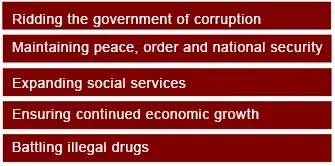The Philippines is a republic with a presidential form of government wherein power is equally divided among its three branches: executive, legislative, and judicial. The Legislative branch is authorized to make, alter, and repeal laws through the power vested in the Philippine Congress. This institution is divided into the Senate and the House of Representatives.The Senate is composed of 24 Senators who are elected at large by the qualified voters of the Philippines whereas the House of Representatives is composed of about 250 members of which 20% must be constituted by representatives elected through a party-list system of registered national, regional, and sectoral parties, while the remaining must be elected from legislative districts in the provinces, cities, and municipalities.
The Executive branch is composed of the President, Vice President, the Cabinet, executive departments, independent agencies, boards, commissions, and committees. As the head of state, the President acts as the leader of the national government, and Commander-in-Chief of all armed forces. However, once his/her six-year term is complete he/she cannot be re-elected.
The Cabinet, too, is an extremely vital component of the Executive Branch, comprising the Vice President and the heads of executive departments, and is nominated by the President himself.
The last few years have seen The Philippines grapple with social instability and the most talked about issue at the helm of this instability is the Government’s ‘War on Drugs’. Since President Duterte came into office in 2016 he has attempted to crush drug use in the country with an iron fist. This battle has stirred discontent among sections of the Filipino population because the execution of said ‘war’ has been far from ideal.
According to an opposition senator, the first twenty months of the Duterte Presidency saw the death toll in the drug war surpass 20,000. Furthermore, residents on the ground claim that this drug war has fostered a campaign of extra-judicial killings in impoverished areas of Manila and other urban areas, and the concern surrounding these claims has escalated to a point where the United Nations Human Rights Council and the International Criminal Court have decided to investigate these drug related executions.
The drug war has also been held responsible for the Philippines being ranked the 4th most dangerous place in the world for civilian-targeted violence. The fallout from this war, however, has not derailed President Duterte’s approval rating among Filipinos. In fact, survey data indicates an 82% satisfaction rate with the Duterte drug war. According to political analysts in the country, Filipinos view the drug war as President Duterte following through on his campaign promise of eradicating criminals. It might even be argued that the illegal drug trade prior to President Duterte’s arrival on the scene, warranted such a stern response.
Back in 2012, The United Nations World Drug Report said the Philippines had the highest rate of shabu (methamphetamine) use in East Asia. Moreover, 2015 data from the Philippine Drug Enforcement Agency (PDEA) reported drug-related cases in 20% of barangays (or villages) across the country with Metro Manila being the most affected by drugs. This, however, does not take away from the fact that many Filipinos fear they may become victims of the drug war themselves, and their dissatisfaction towards the Government’s policies is evidenced by the 30,000 strong protest that took place in Manila last year right after President Duterte’s national address. To learn more about the gravity of this drug war, follow the links below: https://www.aljazeera.com/news/2018/02/thousands-protest-deadly-drug-war-philippines-180224084450606.html
https://www.hrw.org/report/2017/03/02/license-kill/philippine-police-killings-dutertes-war-drugs
Religious harmony in the archipelago has suffered a few blows in recent years, the most prominent of which was the May 2017 siege of Marawi City by pro-Islamic State fighters. The five-month long battle was ignited when Islamist insurgents swarmed through the city of Marawi, taking the population of 200,000 hostage and announcing it as a new ‘Capitol’ for Islamic State in South-East Asia. This triggered a State of Emergency and from May to October 2017, with fighting echelons of the Armed Forces of the Philippines (AFoP) deployed to Marawi in the Mindanao region of the Southern Philippines. The southern region of the country, in particular the Mindanao region, has had an embattled past and has proven a haven for Islamist terrorists for many years.
A 2008 report by the Combating Terrorism Centre at West Point Academy in the United States found that the wider Mindanao area had been connected to numerous high-profile terrorist attacks that had taken place since 9/11—both within and beyond the Philippines—but it had also been identified as an increasingly important hub for leading members of the so-called pro-bombing faction of Jemaah Islamiyah (JI). Historically, Mindanao has also found itself to be the base of separatist extremist organisations such as Abu Sayyaf and the Moro Islamic Liberation Front, and in the period leading up to the siege of Marawi, the region had seen an increase in activity due to an influx of foreign terrorist fighters from the Middle East. To learn more about the history of extremism in Mindanao, follow the link below:
https://cisac.fsi.stanford.edu/mappingmilitants/profiles/moro-islamic-liberation-front#_ftn3
The cost of the battle in Marawi cannot be overstated. The mass destruction flattened entire city blocks, killing 165 members of the AFoP and 47 civilians. This siege, however, has prompted the government to take stronger measures towards curbing future terrorism by addressing sectors in society where it is likely to breed. An example of this would be the approval of the National Action Plan on Preventing and Countering Violent Extremism. To read about this plan, follow the link below:
While President Duterte’s goals and priorities as the Head of State may have been overshadowed by his controversial war on drugs, that alone does not encompass his aims for the country. The President’s efforts can be outlined by the following broad objectives:
